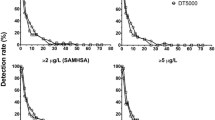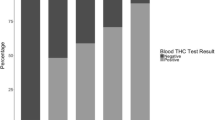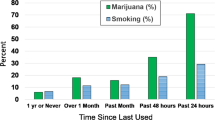Abstract
Oral fluid (OF) is an advantageous matrix for cannabis detection, with on-site tests available for roadside drug-impaired driver screening. Limited data exist for device performance following consumption of vaporized cannabis, which reduces exposure to harmful combustion by-products. We assessed cannabinoid OF disposition, with and without alcohol, and evaluated on-site Dräger® DrugTest 5000 performance (Dräger) following controlled vaporization of cannabis. Forty-three cannabis smokers (≥1×/3 months, ≤3 days/week) reported 10–16 h prior to dosing, and drank placebo or low-dose alcohol [target ~0.065 % peak breath-alcohol concentration (BrAC)] 10 min prior to inhaling 500 mg of placebo, low-dose [2.9 % ∆9-tetrahydrocannabinol (THC)], or high-dose (6.7 % THC) vaporized cannabis (within-subjects; six possible alcohol–cannabis combinations; 19 completers). BrAC readings and OF (Quantisal™, Dräger) were collected before and up to 8.3 h post-dose. Median [range] maximum OF concentrations (C max) for low and high doses (no alcohol, N = 19) were 848 [32.1–18,230] and 764 [25.1–23,680] µg/l THC; 6.0 [0–100] and 26.8 [1.0–1106] µg/l cannabidiol; 54.4 [1.8–941] and 29.7 [0–766] µg/l cannabinol; and 24.1 [0–686] and 18.0 [0–414] ng/l 11-nor-9-carboxy-THC (THCCOOH). Lack of significant differences in THC concentration between low doses and high doses indicated that participants may have titrated doses. THC, cannabidiol and cannabinol C max values were immediately post-inhalation, but metabolite THCCOOH t max showed interindividual variability. Concurrent alcohol did not affect OF cannabinoid concentrations or on-site test sensitivity. With a THC confirmation cutoff of 5 µg/l, Dräger sensitivity, specificity, and efficiency were 60.8, 98.2, and 82.5 %. Dräger had lower sensitivity after 6.7 % THC vaporization (53.8 %, THC ≥2 µg/l confirmation cutoff) than reported following smoking a 6.8 % THC cigarette, but high specificity (99.3 %) and comparable efficiency (65.0 %). Vaporized THC bioavailability may be lower than that when smoked. Confirmation cutoff, time course, intake histories, and additional cannabinoid analytes also affect OF interpretation.




Similar content being viewed by others
References
Lacey JH, Kelley-Baker T, Furr-Holden D, Voas RB, Romano E, Ramirez A, Brainard K, Moore C, Torres P, Berning A (2009) 2007 National roadside survey of alcohol and drug use by drivers: drug results. DOT HS 811 249 National Highway Traffic Safety Administration Office of Behavioral Safety Research, Washington, DC
Davey J, Leal N, Freeman J (2007) Screening for drugs in oral fluid: Illicit drug use and drug driving in a sample of Queensland motorists. Drug Alcohol Rev 26:301–307
Poulsen H, Moar R, Troncoso C (2012) The incidence of alcohol and other drugs in drivers killed in New Zealand road crashes 2004–2009. Forensic Sci Int 223:364–370
Hartman RL, Huestis MA (2013) Cannabis effects on driving skills. Clin Chem 59:478–492
Ramaekers JG, Robbe HWJ, O’Hanlon JF (2000) Marijuana, alcohol and actual driving performance. Hum Psychopharm 15:551–558
Ramaekers J, Kauert G, Theunissen E, Toennes S, Moeller M (2009) Neurocognitive performance during acute THC intoxication in heavy and occasional cannabis users. J Psychopharmacol 23:266–277
Bosker WM, Theunissen EL, Conen S, Kuypers KP, Jeffery WK, Walls HC, Kauert GF, Toennes SW, Moeller MR, Ramaekers JG (2012) A placebo-controlled study to assess standardized field sobriety tests performance during alcohol and cannabis intoxication in heavy cannabis users and accuracy of point of collection testing devices for detecting THC in oral fluid. Psychopharmacology 223:439–446
Charlton SG, Starkey NJ (2013) Driver risk from blood alcohol levels between 50 mg/100 ml and 80 mg/100 ml. NZ Transport Agency Research Report Traffic and Road Safety Research Group. University of Waikato, Hamilton
Johnson MB, Kelley-Baker T, Voas RB, Lacey JH (2012) The prevalence of cannabis-involved driving in California. Drug Alcohol Depen 123:105–109
Rocky Mountain High Intensity Drug Trafficking Area (2013) The legalization of marijuana in Colorado: the impact 1:1–66
Bosker WM, Huestis MA (2009) Oral fluid testing for drugs of abuse. Clin Chem 55:1910–1931
Drummer OH (2006) Drug testing in oral fluid. Clin Biochem Rev 27:147–159
Wille SM, Di Fazio V, Toennes SW, van Wel JH, Ramaekers JG, Samyn N (2014) Evaluation of Δ9-tetrahydrocannabinol detection using DrugWipe5S screening and oral fluid quantification after Quantisal collection for roadside drug detection via a controlled study with chronic cannabis users. Drug Test Anal. doi:10.1002/dta.1660
Bogstrand ST, Gjerde H (2014) Which drugs are associated with highest risk for being arrested for driving under the influence? A case–control study. Forensic Sci Int 240:21–28
Kelley-Baker T, Moore C, Lacey JH, Yao J (2014) Comparing drug detection in oral fluid and blood: data from a national sample of nighttime drivers. Traffic Inj Prev 15:111–118
Substance Abuse and Mental Health Services Administration (SAMHSA) (2004) Notice of proposed revisions to the mandatory guidelines for federal workplace drug testing programs. Fed Regist 69:19673–19732
Pil K, Raes E, Van den Neste T, Verstraete A (2007) Toxicological analyses in the DRUID epidemiological studies: analytical methods, target analytes and analytical cut-offs. Paper presented at the The European Integrated Project DRUID 2007
Baggio S, Deline S, Studer J, Mohler-Kuo M, Daeppen JB, Gmel G (2014) Routes of administration of cannabis used for nonmedical purposes and associations with patterns of drug use. J Adolesc Health 54:235–240
Huestis MA, Henningfield JE, Cone EJ (1992) Blood cannabinoids I. Absorption of THC and formation of 11-OH-THC and THCCOOH during and after smoking marijuana. J Anal Toxicol 16:276–282
Lee D, Schwope DM, Milman G, Barnes AJ, Gorelick DA, Huestis MA (2012) Cannabinoid disposition in oral fluid after controlled smoked cannabis. Clin Chem 58:748–756
Huestis MA, Sampson AH, Holicky BJ, Henningfield JE, Cone EJ (1992) Characterization of the absorption phase of marijuana smoking. Clin Pharmacol Ther 52:31–41
Pomahacova B, Van der Kooy F, Verpoorte R (2009) Cannabis smoke condensate III: the cannabinoid content of vaporised Cannabis sativa. Inhal Toxicol 21:1108–1112
Fischedick J, Van Der Kooy F, Verpoorte R (2010) Cannabinoid receptor 1 binding activity and quantitative analysis of Cannabis sativa L. smoke and vapor. Chem Pharm Bull (Tokyo) 58:201–207
Abrams DI, Vizoso HP, Shade SB, Jay C, Kelly ME, Benowitz NL (2007) Vaporization as a smokeless cannabis delivery system: a pilot study. Clinic Pharmacol Ther 82:572–578
Zuurman L, Roy C, Schoemaker R, Hazekamp A, den Hartigh J, Bender J, Verpoorte R, Pinquier J, Cohen A, van Gerven J (2008) Effect of intrapulmonary tetrahydrocannabinol administration in humans. J Psychopharmacol 22:707–716
Van Dam NT, Earleywine M (2010) Pulmonary function in cannabis users: support for a clinical trial of the vaporizer. Int J Drug Policy 21:511–513
Earleywine M, Barnwell SS (2007) Decreased respiratory symptoms in cannabis users who vaporize. Harm Reduct J 4:11
Toennes SW, Kauert GF, Steinmeyer S, Moeller MR (2005) Driving under the influence of drugs—evaluation of analytical data of drugs in oral fluid, serum and urine, and correlation with impairment symptoms. Forensic Sci Int 152:149–155
Musshoff F, Hokamp EG, Bott U, Madea B (2014) Performance evaluation of on-site oral fluid drug screening devices in normal police procedure in Germany. Forensic Sci Int 238:120–124
Wille SM, Samyn N, Ramírez-Fernández Mdel M, De Boeck G (2010) Evaluation of on-site oral fluid screening using Drugwipe-5+, RapidSTAT and Drug Test 5000 for the detection of drugs of abuse in drivers. Forensic Sci Int 198:2–6
Toennes SW, Schneider K, Wunder C, Kauert GF, Moeller MR, Theunissen EL, Ramaekers JG (2013) Influence of ethanol on the pharmacokinetic properties of Δ9-tetrahydrocannabinol in oral fluid. J Anal Toxicol 37:152–158
Desrosiers NA, Lee D, Schwope DM, Milman G, Barnes AJ, Gorelick DA, Huestis MA (2012) On-site test for cannabinoids in oral fluid. Clin Chem 58:1418–1425
Desrosiers NA, Milman G, Mendu DR, Lee D, Barnes AJ, Gorelick DA, Huestis MA (2014) Cannabinoids in oral fluid by on-site immunoassay and by GC-MS using two different oral fluid collection devices. Anal Bioanal Chem 406:4117–4128
Lee D, Milman G, Schwope DM, Barnes AJ, Gorelick DA, Huestis MA (2012) Cannabinoid stability in authentic oral fluid after controlled cannabis smoking. Clin Chem 58:1101–1109
Milman G, Barnes AJ, Lowe RH, Huestis MA (2010) Simultaneous quantification of cannabinoids and metabolites in oral fluid by two-dimensional gas chromatography mass spectrometry. J Chromatogr A 1217:1513–1521
Welling PG, Lyons L, Elliott R, Amidon GL (1977) Pharmacokinetics of alcohol following single low doses to fasted and nonfasted subjects. J Clin Pharmacol 17:199–206
Wilkinson PK (1980) Pharmacokinetics of ethanol: a review. Alcoholism Clin Exp Res 4:6–21
Newmeyer MN, Desrosiers NA, Lee D, Mendu DR, Barnes AJ, Gorelick DA, Huestis MA (2014) Cannabinoid disposition in oral fluid after controlled cannabis smoking in frequent and occasional smokers. Drug Test Anal 6:1002–1010
Anizan S, Milman G, Desrosiers N, Barnes AJ, Gorelick DA, Huestis MA (2013) Oral fluid cannabinoid concentrations following controlled smoked cannabis in chronic frequent and occasional smokers. Anal Bioanal Chem 405:8451–8461
Bergamaschi M, Queiroz R, Zuardi A, Crippa J (2011) Safety and side effects of cannabidiol, a Cannabis sativa constituent. Curr Drug Saf 6:237–249
Bergamaschi MM, Queiroz RHC, Chagas MHN, de Oliveira DCG, De Martinis BS, Kapczinski F, Quevedo J, Roesler R, Schroder N, Nardi AE, Martin-Santos R, Hallak JEC, Zuardi AW, Crippa JAS (2011) Cannabidiol reduces the anxiety induced by simulated public speaking in treatment-naive social phobia patients. Neuropsychopharmacology 36:1219–1226
Szaflarski JP, Martina Bebin E (2014) Cannabis, cannabidiol, and epilepsy—from receptors to clinical response. Epilepsy Behav. doi:10.1016/j.yebeh.2014.08.135
Toennes SW, Ramaekers JG, Theunissen EL, Moeller MR, Kauert GF (2010) Pharmacokinetic properties of Δ9-tetrahydrocannabinol in oral fluid of occasional and chronic users. J Anal Toxicol 34:216–221
Malouff JM, Rooke SE, Copeland J (2014) Experiences of marijuana-vaporizer users. Subst Abus 35:127–128
Lee D, Vandrey R, Mendu DR, Murray JA, Barnes AJ, Huestis MA (2014) Oral fluid cannabinoids in chronic frequent cannabis smokers during ad libitum cannabis smoking. Drug Test Anal. doi:10.1002/dta.1718
Huestis MA, Cone EJ (2004) Relationship of Δ9-tetrahydrocannabinol concentrations in oral fluid and plasma after controlled administration of smoked cannabis. J Anal Toxicol 28:394–399
Milman G, Schwope DM, Gorelick DA, Huestis MA (2012) Cannabinoids and metabolites in expectorated oral fluid following controlled smoked cannabis. Clin Chim Acta 413:765–770
Verstraete AG (2005) Oral fluid testing for driving under the influence of drugs: history, recent progress and remaining challenges. Forensic Sci Int 150:143–150
Moore C, Coulter C, Uges D, Tuyay J, van der Linde S, van Leeuwen A, Garnier M, Orbita J Jr (2011) Cannabinoids in oral fluid following passive exposure to marijuana smoke. Forensic Sci Int 212:227–230
Milman G, Barnes AJ, Schwope DM, Schwilke EW, Darwin WD, Goodwin RS, Kelly DL, Gorelick DA, Huestis MA (2010) Disposition of cannabinoids in oral fluid after controlled around-the-clock oral THC administration. Clin Chem 56:1261–1269
Fabritius M, Chtioui H, Battistella G, Annoni JM, Dao K, Favrat B, Fornari E, Lauer E, Maeder P, Giroud C (2013) Comparison of cannabinoid concentrations in oral fluid and whole blood between occasional and regular cannabis smokers prior to and after smoking a cannabis joint. Anal Bioanal Chem 405:9791–9803
Lee D, Milman G, Barnes AJ, Goodwin RS, Hirvonen J, Huestis MA (2011) Oral fluid cannabinoids in chronic, daily cannabis smokers during sustained, monitored abstinence. Clin Chem 57:1127–1136
Maseda C, Hama K, Fukui Y, Matsubara K, Takahashi S, Akane A (1986) Detection of Δ9-THC in saliva by capillary GC/ECD after marihuana smoking. Forensic Sci Int 32:259–266
Lukas SE, Benedikt R, Mendelson JH, Kouri E, Sholar M, Amass L (1992) Marihuana attenuates the rise in plasma ethanol levels in human subjects. Neuropsychopharmacology 7:77–81
Abalo R, Vera G, Lopez-Perez AE, Martinez-Villaluenga M, Martin-Fontelles MI (2012) The gastrointestinal pharmacology of cannabinoids: focus on motility. Pharmacology 90:1–10
Izzo AA, Sharkey KA (2010) Cannabinoids and the gut: new developments and emerging concepts. Pharmacol Therapeut 126:21–38
Dubowski KM (1985) Absorption, distribution and elimination of alcohol: highway safety aspects. J Stud Alcohol 10:98–108
Laloup M, del Mar Ramirez Fernandez M, Wood M, De Boeck G, Maes V, Samyn N (2006) Correlation of Δ9-tetrahydrocannabinol concentrations determined by LC-MS-MS in oral fluid and plasma from impaired drivers and evaluation of the on-site Dräger DrugTest. Forensic Sci Int 161:175–179
Logan BK, Mohr AL, Talpins SK (2014) Detection and prevalence of drug use in arrested drivers using the Dräger Drug Test 5000 and Affiniton DrugWipe oral fluid drug screening devices. J Anal Toxicol 38:444–450
Gieringer D, St. Laurent J, Goodrich S (2004) Cannabis vaporizer combines efficient delivery of THC with effective suppression of pyrolytic compounds. J Cannab Therapeut 4:7–27
Chemic Laboratories (2003) Evaluation of Volcano vaporizer for the efficient emission of THC, CBD, CBN and the significant reduction and/or elimination of polynuclear-aromatic (PNA) analytes resultant of pyrolysis. Report No. 1311619-0103-2563, Canton; pp 1–57
Henningfield JE, Fant RV, Radzius A, Frost S (1999) Nicotine concentration, smoke pH and whole tobacco aqueous pH of some cigar brands and types popular in the United States. Nicotine Tob Res 1:163–168
Hazekamp A (2010) The Volcano Medic cannabis vaporizer: optimal temperature for single-dose administration of 100 mg cannabis or 10 mg dronabinol. LabAssistent Phytochemical Services Project No. 2010-003c, Leiden; pp 1–13
Hazekamp A, Ruhaak R, Zuurman L, van Gerven J, Verpoorte R (2006) Evaluation of a vaporizing device (Volcano) for the pulmonary administration of tetrahydrocannabinol. J Pharm Sci 95(6):1308–1317
Drummer OH (2005) Review: pharmacokinetics of illicit drugs in oral fluid. Forensic Sci Int 150:133–142
Acknowledgments
We thank the nurses and staff of the University of Iowa Clinical Research Unit, as well as the staff of the National Advanced Driving Simulator, for contributions to data collection. We further acknowledge Cheryl Roe, Jennifer Henderson, Rose Schmitt, and Kayla Smith for data assembly and coordination, and Allan J. Barnes for instrumentation expertise. We acknowledge the University of Maryland, Baltimore Toxicology Program, and the Graduate Partnership Program, National Institutes of Health (NIH). The Dräger DrugTest 5000, Quantisal, and Volcano devices and supplies were provided by the manufacturers to NIH through Materials Transfer Agreements. This research was funded by the Intramural Research Program, National Institute on Drug Abuse, NIH, the United States Office of National Drug Control Policy, and the National Highway Traffic Safety Administration.
Conflict of interest
Ms. Hartman and Drs. Anizan, Jang, Yun, Gorelick, and Huestis report research funding through interagency agreements from the National Highway Traffic Safety Administration and the Office of National Drug Control Policy; and nonfinancial support (devices provided via Materials Transfer Agreements) from Storz-Bickel, Immunalysis, and Dräger, during the course of the study. Dr. Yun additionally reports grant funding from the National Key Technology R&D Program of China (2012BAK02B02-2). Drs. Brown, Milavetz, Spurgin, and Gaffney report contract research funding from the National Highway Traffic Safety Administration, the Office of National Drug Control Policy, and the National Institute on Drug Abuse; and nonfinancial support (devices provided via Materials Transfer Agreements) from Storz-Bickel, Immunalysis, and Dräger, during the course of the study. No commercial organization participated in study design, data analysis, or manuscript writing.
Author information
Authors and Affiliations
Corresponding author
Electronic supplementary material
Below is the link to the electronic supplementary material.
Rights and permissions
About this article
Cite this article
Hartman, R.L., Anizan, S., Jang, M. et al. Cannabinoid disposition in oral fluid after controlled vaporizer administration with and without alcohol. Forensic Toxicol 33, 260–278 (2015). https://doi.org/10.1007/s11419-015-0269-6
Received:
Accepted:
Published:
Issue Date:
DOI: https://doi.org/10.1007/s11419-015-0269-6




